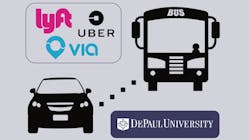Public transit’s “road to recovery” could include more ridesharing partnerships says DePaul study
The road to recovery for public transit agencies in the wake of the coronavirus ridership collapse may take unpredictable turns. Fewer traditional rush-hour commuters may travel to and from downtown districts on transit while public health concerns persist. Some employers will likely make certain work-at-home arrangements permanent. The degree to which government agencies struggle with revenue shortfalls remains to be seen.
Agencies grappling with these issues, as a study by DePaul University with support from the Shared-Used Mobility Center, have good reason to explore collaborations with ridesharing providers that give them valuable experience with new types of services. The study, 21 Key Takeaways from Partnerships between Public Transit Providers and Transportation Network Companies in the United States, explores the risk and rewards of partnerships involving rideshare providers such as Lyft, Uber and Via to provide on-demand service. These programs run the gamut from discounts for rides to bus or train stops, to eliminating “transit deserts” and giving new options to disadvantaged populations.
The study team looked at the experiences of 10 public agencies directly involved in on-demand partnerships and it drew insights from consultations with representatives both from these agencies and from TNCs, as well as from previously published research. Among the ten on-demand programs reviewed are Greater Dayton Regional Transit Authority’s Connect On-Demand program, which offers free Lyft and Uber trips to residents affected by reductions in bus service; the city of Detroit’s NightShift program, which offers discounted Lyft trips to certain transit stops at off-peak times; and St. Petersburg, Florida’s Pinellas Suncoast Transit Authority (PTSA) Direct Connect program, which subsidizes rideshare trips in certain areas poorly served by its buses.
Partnerships to provide on-demand program, the study warns, are not without risk. To lessen the chance of unwanted surprises, the study finds that agencies must:
• Establish rules that limit the risk of traffic diversion from scheduled bus and train service. This may mean limiting offerings to particular geographic areas (called “geofencing”), as is being done in the Dayton, Detroit and PTSA programs, or limiting service to certain types of customers, as is being done in metropolitan Boston’s On-Demand Paratransit Pilot Program, which limits Lyft and Uber discounts to the paratransit-eligible.
• Be ready to accept a certain amount of trial-and-error to move up the learning curve. “Finding the sweet-spot between being overly generous and overly restrictive can take months or even years,” said Joseph P. Schwieterman, a co-author of the study.
• Grapple with vexing “cost versus control” issues that sometimes haunt agencies. A subsidy-only program, such as a fixed discount on all rideshare trips meeting certain criteria, is often the lowest-cost option. Nevertheless, this strategy often comes at the expense of having ready access to driver and customer information and the ability to set certain performance standards. Small programs catering to seniors and people with mobility impairments tend to avoid this approach as a result.
• Make it a priority to incorporate on-demand programs into the larger transit system through signage and other means and especially by working toward payment integration.
• Exercise patience. “Agencies often must allow for more time than they initially expect to see reliable results, as consumers often need time to become familiar with a new program and adjust their travel habits,” noted Mallory Livingston Shurna, the study’s other co-author.
Their findings suggest that creating successful partnerships requires agencies to look to the long term and be ready to make adjustments. Some agencies, for example, have found the demand for wheelchair-accessible vehicles to be lower than anticipated. The authors point to a variety of factors, including the challenge of spreading the word about programs and their accessible options, as possible explanations.
DePaul University invites all to a free webinar on the study on Thursday April 16, 2020 from 12 – 1 p.m. Central (1 – 2 p.m. Eastern). Presenters include Livingston Shurna, as well as representatives from King County Transit’s Via to Transit program in Seattle, Wash., and Marin Transit’s Connect program in California. Schwieterman, a DePaul University professor, will serve as moderator.
Email [email protected] to register or to reach the study team. To download the study, click here.
